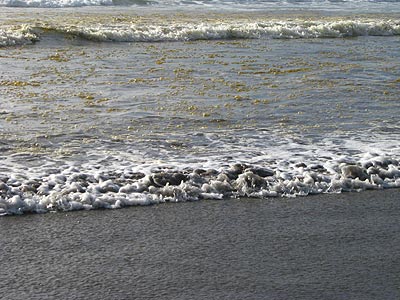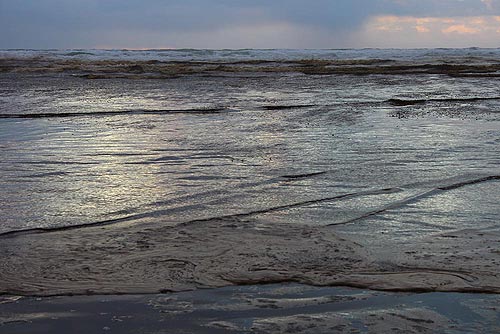Dark, Oily Waves on North Oregon Coast a Positive Thing
Published 04/03/2011

(Seaside, Oregon) – It's mostly dark brown but sometimes black; and it's oily and greasy looking, showing up in thick globs and patches. It's reminiscent of the Gulf Oil Disaster earlier this year, even leaving mass dark stains on the beaches.
And yet the craziest irony is that it’s a good thing. A very good thing.
Some parts of the surf on the north Oregon coast are much more oily-looking than normal right now. It's actually unnerving - considerably darker than usual. Even though it looks oily and sludgy, it's a sign of a healthy ocean.
Surf in Seaside has a prominent brown tinge to it all around town, which happens rather frequently here because of a form of phytoplankton called dinoflagellates (there are several different kinds of dinoflagellates as well). But right now - at least in one section of this sandy beach - it's extremely brown and gritty looking. Much more so than the rest of Seaside's brownish tint.

It happens because currents move the dinoflagellates here in great abundance, and these currents make some areas look browner than others by pushing more dinoflagellates in. Saturday, there was a 300-foot stretch of Seaside that was almost black in places, while other spots north and south of it were varying degrees of brown.
Dinoflagellates "bloom" in this part of the north Oregon coast in great numbers because of the nutrients carried into the sea by the Columbia River. All the rain the area has had lately might have something to do with the larger blooms, but phytoplankton always bloom more in the spring.
 |
| Brown waves in Seaside usually look a little more like this |
Normally, the dinoflagellates flood the area and make the breakers a different shade of brown, with the waves often carrying in blobs of brown bubbles or shades of brown. This thick, almost black oily is a bit more than usual – at least to the casual observer, and even to the seasoned observer.
Keith Chandler, manager of Seaside Aquarium, said these extremely dark waves shouldn’t be that shocking anymore to visitors on the north coast.
“It happens all the time,” he said. “It’s probably not even the darkest it’s ever been.”
Chandler said this could end up making razor clamming excellent, as these clams eagerly come to the surface to eat up the dinoflagellates. But so far clamming has not been good, partially because of weather and tide conditions.
“We haven’t had a good set” Chandler said.
The term “set” refers to the testing of numbers of clams.
 |
| Brown waves in Seaside |
Chandler said large waves and stormy conditions are probably interfering with clamming on this part of the coast. He said he’s been kicked around by some recent tidal surges.
“I was knocked over by a couple of big waves – and I’ve never gotten knocked around by waves in years of clamming,” Chandler said. “I’ve talked to other clammers and they’ve said it hasn’t been good either, because of the stormy conditions.”
Lots of dinoflagellates also results in plenty of other kinds of phytoplankton, which can mean extremely large amounts of foam, which make for spectacular and strange stormy wave action at times. This could also mean the “glowing sand” phenomenon at night, where a form of bioluminescent phytoplankton creates tiny bluish green sparks when walked on in certain wet sand areas. Oregon Coast Lodgings for this event - Where to eat - Maps - Virtual Tours

More About Oregon Coast hotels, lodging.....
More About Oregon Coast Restaurants, Dining.....
LATEST Related Oregon Coast Articles
One was a rare orca find; both suspected human interaction. Marine sciences
N. Oregon Coast's 'Cheese War' a Quiet Part of Tillamook-Area History: See th...
History talk in Nehalem on April 26 about Tillamook battles. Manzanita events, Cannon Beach events, Tillamook events
Lyrid Meteors with a Possible Side of Aurora for Washington, Oregon, Coastlines
Lyrids peak on Monday, northern lights possible northern Washington. Weather
Road Work Coming to North Oregon Coast's Gearhart and One of World's Largest ...
Lane closures this summer on the bridge; major work in Gearhart next year. Washington coast
Be Jeweled Returns to Central Oregon Coast, Newport's Dazzling, Arty Jewelry ...
Saturday, May 10, from 10 AM to 4 PM featuring more than 2,000 pieces. Newport events
N. Oregon Coast Bridge Work During Travel Season: Some Traffic Delays on Asto...
Occasional one-lane traffic from June through September at Astoria / Ilwaco. Washington coast
Cape Kiwanda's Colossal Sand Dune: Wild Oregon Coast Rides and How It's Changing
A mix of crazy recreation with science of a crumbling landmark. Sciences, Pacific City, Oceanside
Oregon Coast, Valley and Likely Washington Coast to Get Some Aurora Borealis ...
Likely just before dawn best hour but peak happens during daylight. Weather
Back to Oregon Coast
Contact Advertise on BeachConnection.net
All Content, unless otherwise attributed, copyright BeachConnection.net Unauthorized use or publication is not permitted











































